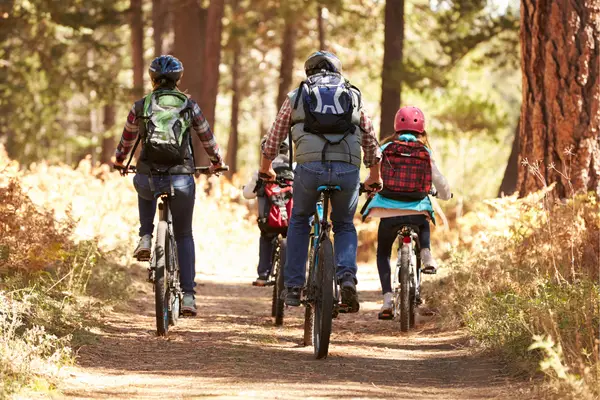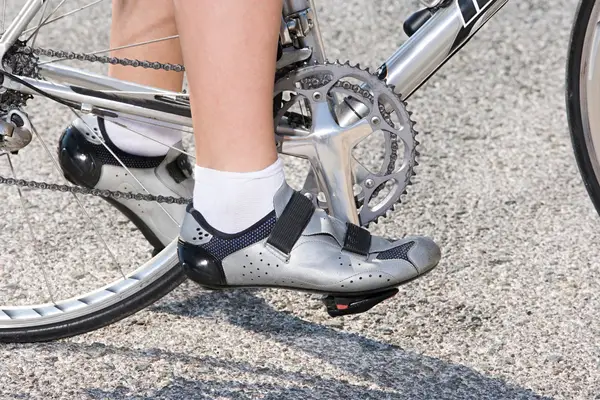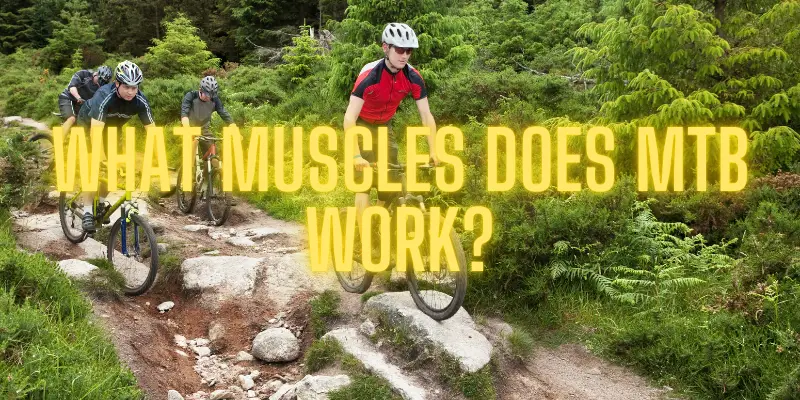Most of us took up mountain biking for the fun of it. But under the hood, mountain biking works and develop our muscles.
I for one, never really gave it much thought. Recently, I figured out how amazing the work done by the muscles is when we ride bikes.
Our muscles play a major role when mountain biking and here is a tell all on what muscles are used and worked when mountain biking.
What is mountain biking really?
Mountain biking or better still MTB is a cycling sport or exercise usually done off the main roads and on rough terrain.

Cycling is an amazing sport and helps develop the rider physically. There have been quite a few conversations with regards to the differences between the mountain biking and regular biking.
Road Cycling is done when riding on a paved road, while Track Cycling is done on a track (obviously).
They tend to work more on endurance, feet, and leg muscles, while the mountain biking works more on your glutes, hamstrings, quadriceps, calves and feet muscles.
Related post: How many calories do you burn mountain biking
Different types of Mountain Biking
Before I get into the different types of mountain biking, you should know all these categories of MTB have one thing in common.
They all work the muscles on the body of the rider. From the head and all the way down to the feet, the rider uses several muscles when riding a mountain bike.
Some of these categories are:
- downhill mountain biking
- four-cross mountain biking
- cross-country mountain biking
- enduro mountain biking
- free-ride mountain biking, etc.
Muscles used when mountain biking
Mountain biking develops the muscles of the buttock, hamstring, quads, calf, shoulder, arms & forearms, chest, and the core muscles.
All these muscles in the body are used when mountain biking. Different muscles are primarily used on different terrains.
Today, I’ll go over all the muscles in the body that are used when mountain biking. We’ve got the
- upper body muscles
- lower body muscles
- mid body/core muscles
Related post: Benefits of Mountain Biking
The Upper Body Muscles and MTB
So, what happens to the muscles and which muscles are used when shifting or gripping the MTB handle bars?

You see, your biceps help you hold stable and firm when on the MTB. Usually when balancing on a two-wheeler, the upper body muscles play a major role in preventing you from falling over on either side.
The arms and forearms are responsible for applying the brakes, shifting, and gripping the MTB which are extremely important.
When riding, your triceps, and pectoral muscles (chest muscles) also come into play. While biking on a straight plain surface, your triceps and pectoral muscles are usually relaxed.
However, when your bike is on an incline or descent, your triceps and pectoral muscles work to aid your biceps in keeping you stable and in control of your bike.
When you are riding this way, you tend to feel yourself riding against gravity and the force pulling at you as you ride up a hill or when you descend one.
Your triceps and pectoral muscles help hold off this force and keep you stable.
Related post: Are Vans good shoes for MTB?
The Lower Body Muscles and MTB
In addition to the upper body, the lower body muscles are also in action when mountain biking.
The quads…, when people talk about the quads during workout conversations, do you often ask yourself what exactly the quad is and where it is located on your body?
Well let me help you out…
The quad is one of the most talked of muscle areas in the lower body and working it out is no small feat.
Better known as the quadriceps, this merge of muscles is a group of 4 muscles formed together on the front of the leg and just above the knee.
Muscles of the quadriceps
- Rectus fermoris
- Vastus intermedius
- Vastus lateralis
- Vastus medialis
The rectus fermoris, vastus intermedius, vastus lateralis and vastus medialis are the muscles that make up the quad muscle.

These muscles alongside the calf muscle work together in the up and down movement of the legs while pedaling the MTB.
As a rider, the ache you feel on your thigh just above your knee when cycling is your quads being put to work.
MTB works quite a few muscles on the lower body. The hamstrings are under quads, below your thigh, just underneath the buttock.
While cycling, the hamstrings and the calf muscle work with buttock muscles to stabilize the rider while pedaling.
The Mid Body Muscles and MTB
Do you tend to feel an intense ache in your mid-section when you have done some strenuous exercises such as high knee jogging, cycling or sit-ups?
That is your rectus abdominus and your core area introducing themselves.
These muscles both work together when mountain biking to stabilize you while you are descending and climbing a hill.
These muscles keep you stable as you are seated in the same position during long periods of cycling.
Other Essentials
There is a lot more information when it comes to the muscles that are being used when mountain biking. One of the most important elements of biking is pedaling.
You can’t discuss the muscles used in mountain biking without bringing up the different phases of a pedal stroke.
Related Post: Effect of Cycling on the body (male & female)
Pedal Stroke: Explained
Pedaling or the pedal stroke is broken down into 2 phases. The power phase and the recovery phase.
Power Phase
On an MTB, during the power phase (when starting off your cycling), many muscles in the lower body are being put to work as you begin your ride.
The glute muscles, the hamstring, the vastus lateralis, vastus medialis and soleus are all worked as the rider starts his or her journey or when he or she is riding up a hill.

Recovery Phase
In the recovery phase, the iliopsoas which is the strongest of the hip flexor muscles tightens up (flexes).
In recovery, the glute muscles, the hamstring, the vastus lateralis, vastus medialis, soleus, calf muscles, hip flexor muscles, and shin muscles combine to keep yourself and the mtb stable.
For a more in-depth understanding of the pedal stroke, check out this article from Bike Test Reviews.
Suggested post: Does bike riding cause hemorrhoids?
Why Mountain Biking is Great for You and your Muscles
Mountain biking is an amazing full body workout, but most importantly it builds your physical and mental abilities.
Some benefits for your muscles from riding mountain bikes are;
- Lower body workout:
Pedaling and cycling through rough terrains allows your body to transfer energy to move the bike as the thigh and leg muscles do most of the work.
- Upper body workout:
The workout done by the upper body when mountain biking increases your upper body’s physical strength and stamina while working the muscles in the arms, forearms, and chest.
- Benefits to the internal organs:
Do you know mountain biking is a cardiovascular exercise?
Internal organs like the brain, the lungs, the heart benefit massively from the mountain biking as these internal organs consist of and work with muscles that are worked out and strengthened.
Conclusion
Mountain biking is an activity like any other which has its advantages and risks.
Nevertheless, mountain biking is a great way to keep fit, healthy and best develop our body muscles.
From our internal organs like our lungs, heart, and brain to the rest of our entire body, our muscles are all worked when mountain biking.
If you are looking for an adventure, fun as well as full body workout, mountain biking is the way to go.


